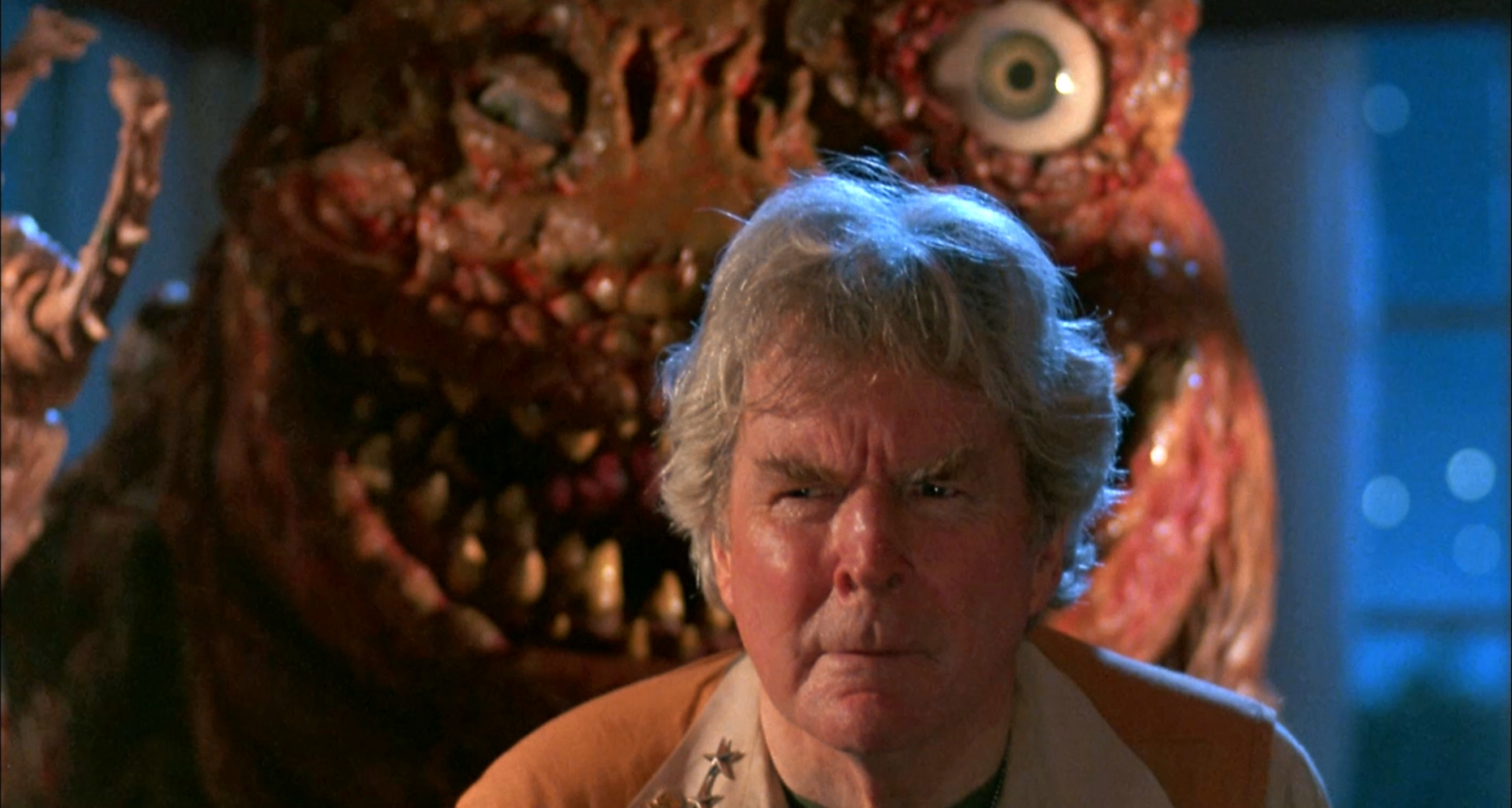Editorials
Ted Nicolaou’s ‘TerrorVision’ Pulls No Punches on 1980s America
November 9th, 2020 | By Jessica Scott

If TerrorVision is even discussed at all, it’s usually brought up as an example of “so bad it’s good” cinema. Writer-director Ted Nicolaou’s campy, gooey satire is both a twisted love letter to Atomic Age creature features and a wide-ranging critique of American life in the ‘80s. Each character represents a different aspect of the American psyche, from xenophobia to our fascination with the military and survivalism to our inability to detach from electronic devices and mindless entertainment. Nicolaou’s film never takes itself seriously for a single second, but as pointed commentary, it doesn’t take American society seriously either.
TerrorVision is, admittedly, a weirdo movie that caters to some pretty niche tastes, but while its reputation has been somewhat rehabilitated since its release, it deserves an even wider audience than it currently enjoys. The film faced an uphill battle when it opened in theatres, especially given its unfortunate timing: the film was released on Valentine’s Day of 1986, less than three weeks after the Space Shuttle Challenger tragedy unfolded on live television. In the wake of such a disaster, perhaps the American public wasn’t in the mood to see itself lampooned in a sci-fi horror comedy filled with sex jokes and gallons of alien ooze.
TerrorVision is best described as The Thing if it were directed by John Waters instead of John Carpenter. The film features a sleazy, slightly deranged version of the American nuclear family as they fail to thwart an extraterrestrial invasion. Cult horror film mainstays Gerrit Graham and Mary Woronov play Stan and Raquel Putterman, aspiring swingers whose taste in home decor heavily favors clashing neons and nude women. They have two children, Suzy (Diane Franklin) and Sherman (Chad Allen), whom Stan and Raquel seem to view as little more than an impediment to their sex life. Bert Remsen rounds out the family unit as Grampa, a paranoid survivalist who spends his days informing strangers of the benefits of lizard tail jerky.
Stan is the stereotypical American dad, obsessing over his state-of-the-art new satellite dish and telling anyone who will listen about how many channels it gets. It’s through this satellite dish that the alien — “Hungry Beast,” a pet/garbage disposal unit mutation from the planet Pluton that will devour anything in its path — travels to Earth and begins to dominate the planet through television airwaves. In one of the film’s sharpest indictments of American culture, we learn that the insatiable Hungry Beast can be defeated if people simply stop watching television for about 200 years. The Puttermans can’t take their eyes off their TVs for a single minute though, even when they have no idea what they’re watching, so any hope of the Earth’s survival dies along with their attention span.
The insipid shallowness of American culture in the ‘80s is on bright display in TerrorVision. Raquel and Suzy are most concerned with appearances. Raquel is an aerobics fanatic with an impressive wardrobe of spandex leotards and Naugahyde dresses for her swinger meet-ups. Suzy is an ‘80s fashion icon who combines Cyndi Lauper-meets-Madonna realness with a hint of her parents’ love for neon excess. Suzy’s boyfriend O.D. (Jon Gries) is a consummate metalhead, matching Suzy in her substitution of aesthetic for personality. He spends most of the film shredding his air guitar and making sure his (leather ensemble) looks could kill. Though MTV addicts may seem like an easy target, TerrorVision’s humor is a little too obscure to be considered a broad parody. The film is less interested in mocking specific tastes and styles than mocking people who lack the depth to develop an identity beyond their taste in clothing and music.
Grampa and Sherman frequently hang out in Grampa’s military-style bunker that’s filled with grenades, machine guns, first aid kits, and the aforementioned lizard tail jerky. The ‘80s weren’t the only decade to see America embrace its jingoistic side, but with the popularity of toys and cartoons like G.I. Joe and movies like Red Dawn, the last full decade of the Cold War certainly felt like the apotheosis of militaristic and survivalist fantasies in 20th-century pop culture. Putting the lie to American supremacy and exceptionalism, Grampa — the ostensible expert in outlasting any manner of threats — is one of the monster’s first victims.
No ‘80s satire would be complete without an exploration of American greed. TerrorVision takes aim at this materialism when Suzy, Sherman, and O.D. — the few remaining survivors at this point in the movie — decide that they want to exploit the Hungry Beast for money. They invite buxom horror host Medusa (Jennifer Richards) over to the house to meet the Hungry Beast and score their own television contract. Medusa is a clear Elvira stand-in, though she lacks Elvira’s good-natured self-deprecation. When the Hungry Beast devours the last of the survivors and chooses the scantily clad Medusa as the method by which he will take over the planet, the film is underscoring its mockery of Americans’ lust for sex and coy nudity.
Zany, hilarious, and bizarre, TerrorVision is both a celebration and a subversion of the classic creature feature. It takes the ideal ‘50s family — a mom, dad, and two kids, all of whom are white, suburban, and wealthy — and feeds them to a sentient garbage disposal rather than letting them save the day and keep their warped American dream alive. Despite the “unhappy” ending, there’s an underlying sweetness and charm to the film that makes it gloriously fun and endlessly re-watchable. The Hungry Beast is a welcome combination of disturbing and adorable, while the cast’s elastic facial expressions and wild physical comedy turn the film into a live-action Looney Tunes cartoon. The satire is never mean-spirited; TerrorVision aims its off-kilter humor at every target it can find, including itself.
TerrorVision won’t be to everyone’s taste, but it’s not the bastion of “so bad it’s good” cinema that so many people assume. This bright, kooky, and hilarious movie accomplishes exactly what it sets out to do, and it does so in an eminently engaging and entertaining way that has earned it a well-deserved cult status. From the deliberately gaudy production design to the stratospherically over-the-top performances to the gleefully silly special effects, TerrorVision revels in its low-budget weirdness and offers up a wacky yet intelligent critique of America in the ‘80s.
Visit our Editorials page for more articles like this. Ready to support more original horror criticism? Join the Certified Forgotten Patreon community today.


